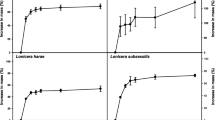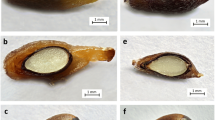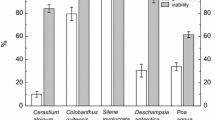Abstract
Seeds of Delphinium fissum subsp. sordidum are physiologically dormant at maturity, with underdeveloped embryos; thus they have morphophysiological dormancy (MPD). The aims of this study were to determine the requirements for embryo growth, dormancy break and germination, to characterise the type of seed dormancy and to evaluate the effects of light, seed age, pollination mechanism, and inter-annual and inter-population variability on germinative ability. After 3 months of incubation at 5°C (cold stratification) in darkness conditions, the mean embryo length increased from 5.6 to 2.07 mm, with 76% of seeds germinating. Conversely, embryos of seeds incubated during 3 months at 20/7 or 28/14°C hardly grew and no germination was recorded. Since cold stratification was the only requirement for the loss of MPD, and both dry storage in laboratory conditions and warm stratification prior to cold stratification shortened the cold stratification period required for germination, it could be concluded that D. fissum subsp. sordidum seeds have intermediate complex MPD. Cold stratification and incubation in darkness conditions promoted higher germination percentages than those in light. In addition, germinative ability increased with seed age up to 8 months (reaching 96% at 5°C in darkness), showed a pronounced inter-annual and inter-population variability, as well as a significant decrease in seeds coming from pollination by geitonogamy. High temperatures (25/10 or 28/14°C) induced seeds to secondary dormancy, so seedling emergence in the greenhouse was restricted to February–March. The requirements for dormancy break and germination reflect an adaptation to trigger germination in late winter. This study is the first one to document a gradual increase in germination percentage with seed age for plant species with intermediate complex MPD.





Similar content being viewed by others
References
Albert MJ, Iriondo JM, Pérez-García F (2002) Effects of temperature and pretreatments on seed germination of nine semiarid species from NE Spain. Isr J Plant Sci 50:103–112
Bañares A, Blanca G, Güemes J, Moreno JC, Ortiz S (2003) Atlas y libro rojo de la flora vascular amenazada de España. Dirección General de Conservación de la Naturaleza, Madrid
Baskin JM, Baskin CC (1978) The seed bank in a population of an endemic plant species and its ecological significance. Biol Conserv 14:125–130
Baskin JM, Baskin CC (1980) Role of seed reserves in the persistence of a local population of Sedum pulchellum: a direct field observation. Bull Torrey Bot Club 107:429–430
Baskin JM, Baskin CC (1989) Seed germination ecophysiology of Jeffersonia diphylla, a perennial herb of mesic deciduous forests. Am J Bot 76:1073–1080
Baskin CC, Baskin JM (1994) Deep complex morphophysiological dormancy in seeds of the mesic woodland herb Delphinium tricorne (Ranunculaceae). Int J Plant Sci 155:738–743
Baskin CC, Baskin JM (1995) Warm plus cold stratification requirement for dormancy break in seeds of the woodland herb Cardamine concatenata (Brassicaceae), and evolutionary implications. Can J Bot 73:608–612
Baskin CC, Baskin JM (1998) Seeds, ecology, biogeography, and evolution of dormancy and germination. Academic Press, San Diego
Baskin JM, Baskin CC (2004) A classification system for seed dormancy. Seed Sci Res 14:1–16
Baskin CC, Baskin JM (2005) Seed dormancy in wild flowers. In: McDonald MB, Kwong FY (eds) Flower seeds: biology and technology. CAB International, Wallingford, pp 163–185
Baskin CC, Baskin JM, Meyer SE (1993) Seed dormancy in the Colorado Plateau shrub Mahonia fremontii (Berberidaceae) and its ecological and evolutionary implications. Southwest Nat 38:91–99
Baskin CC, Meyer SE, Baskin JM (1995) Two types of morphophysiological dormancy in seeds of two genera (Osmorhiza and Erythronium) with an Arcto-Tertiary distribution pattern. Am J Bot 82:293–298
Baskin CC, Baskin JM, Chester EW (2001) Morphophysiological dormancy in seeds of Chamaelirium luteum, a long-lived dioecious lily. J Torrey Bot Soc 128:7–15
Baskin CC, Zackrisson O, Baskin JM (2002) Role of warm stratification in promoting germination of seeds of Empetrum hermaphroditum (Empetraceae), a circumboreal species with a stony endocarp. Am J Bot 89:486–493
Beckstead J, Meyer SE, Allen PS (1996) Bromus tectorum seed germination: between-population and between-year variation. Can J Bot 74:875–882
Bell DT (1993) Germination responses to variations in light quality of eight species from sandy habitats in Western Australia. Aust J Bot 41:321–326
Bell DT, King LA, Plummer JA (1999) Ecophysiological effects of light quality and nitrate on seed germination in species from Western Australia. Aust J Ecol 24:2–10
Blanché C, Molero J (1986) Delphinium. In: Castroviejo S et al (eds) Flora iberica, vol I. Real Jardín Botánico, CSIC, Madrid, pp 242–251
Bloom CT, Baskin CC, Baskin JM (1990) Germination ecology of the facultative biennial Arabis laevigata variety laevigata. Am Midl Nat 124:214–230
Copete MA, Herranz JM, Ferrandis P (2005) Seed dormancy and germination in threatened Iberian Coincya (Brassicaceae) taxa. Ecoscience 12:257–266
DOCM (2002) Decreto 43/2002, de 02-04-2002, por el que se aprueba el Plan de Recuperación de la especie de flora Delphinium fissum subsp. sordidum. DOCM 47: 6347–6349
Elias F, Ruiz L (1981) Estudio agroclimático de la región de Castilla-La Mancha. Junta de Comunidades de Castilla-La Mancha, Toledo
Escudero A, Carnes LF, Pérez-García F (1997) Seed germination of gypsophytes and gypsovags in semi-arid central Spain. J Arid Environ 36:487–497
Fenner M (1991) The effects of the parent environment on seed germinability. Seed Sci Res 1:75–84
Ferrero LM, Montouto O, Herranz JM (2006) Flora amenazada y protegida del Parque Natural del Alto Tajo. Junta de Comunidades de Castilla-La Mancha, Guadalajara
González-Talaván A, Bernardos S, Delgado L, Amich F (2003) Delphinium fissum subsp. sordidum. In: Bañares A, Blanca G, Güemes J, Moreno JC, Ortiz S (eds) Atlas y libro rojo de la flora vascular amenazada de España. Dirección General de Conservación de la Naturaleza, Madrid, pp 672–673
Herranz JM, Ferrandis P, Copete MA (2003) Influence of light and temperature on seed germination and ability of the endangered plant species Sisymbrium cavanillesianum to form persistent soil seed banks. Ecoscience 10:532–541
Hidayati SN, Baskin JM, Baskin CC (2000) Dormancy-breaking and germination requirements of seeds of four Lonicera species (Caprifoliaceae) with underdeveloped embryos. Seed Sci Res 10:459–469
Ikeda H, Itoh K (2001) Germination and water dispersal of seeds from a threatened plant species Penthorum chinense. Ecol Res 16:99–106
Kondo T, Miuraa T, Okuboa N, Shimadaa M, Baskin CC, Baskin JM (2004) Ecophysiology of deep simple epicotyl morphophysiological dormancy in seeds of Gagea lutea (Liliaceae). Seed Sci Res 14:371–378
Leck MA, Parker VT, Simpson RL (1989) Ecology of soil seed banks. Academic Press, London
Lesica P (1993) Loss of fitness resulting from pollinator exclusion in Silene spaldingii (Caryophyllaceae). Madroño 40:193–201
Lorite J, Ruiz-Girela M, Castro J (2007) Patterns of seed germination in Mediterranean mountain: study on 37 endemic or rare species from Sierra Nevada, SE Spain. Candollea 62:5–16
Menges ES (1991) Seed germination percentage increases with population size in a fragmented prairie species. Conserv Biol 5:158–164
Menges ES (1995) Factors limiting fecundity and germination in small populations of Silene regia (Caryophyllaceae), a rare hummingbird-pollinated prairie forb. Am Midl Nat 133:242–255
Meyer SE, Mcarthur ED, Jorgensen GL (1989) Variation in germination response to temperature in rubber rabbitbrush (Chrysothamnus nauseosus: Asteraceae) and its ecological implications. Am J Bot 76:981–991
Milberg P (1994) Germination ecology of the endangered grassland biennial Gentianella campestris. Biol Conserv 70:287–290
Milberg P, Andersson L, Thompson K (2000) Large-seeded species are less dependent on light for germination than small-seeded. Seed Sci Res 10:99–104
Navarro L, Guitian J (2003) Seed germination and seedling survival of two threatened endemic species of the northwest Iberian Peninsula. Biol Conserv 109:313–320
Pavlovic NB (1996) Disturbance-dependent persistence of rare plants, anthropogenic impacts and restoration implications. In: Bowles ML, Whelan CJ (eds) Restoration of endangered species, conceptual issues, planning and implementation. Cambridge University Press, Cambridge, pp 159–193
Pérez-García F, Hornero J, González-Benito ME (2003) Interpopulation variation in seed germination of five Mediterranean Labiatae shrubby species. Isr J Plant Sci 51:117–124
Routley MB, Mavraganis K, Eckert CG (1999) Effect of population size on the mating system in a self-compatible, autogamous plant, Aquilegia canadensis (Ranunculaceae). Heredity 82:518–528
Schemske DW, Husband BC, Ruckelshaus MH, Goodwillie C, Parker IM, Bishop JG (1994) Evaluating approaches to the conservation of rare and endangered plants. Ecology 75:584–606
Solbrig OT (1980) Demography and natural selection. In: Solbrig OT (ed) Demography and evolution in plant populations, vol 15. Botanical Monographs. Blackwell Scientific Publications, Oxford, pp 1–20
Stokes P (1965) Temperature and seed dormancy. In: Ruhland W (ed) Encyclopaedia of plant physiology, vol 15, part 2. Springer, New York, pp 746–803
Thanos CA, Georghiou K (1988) Ecophysiology of fire-stimulated seed germination in Cistus incanus ssp. creticus (L.) Hey wood and C. salvifolius L. Plant Cell Environ 11:841–849
Thanos CA, Georghiou K, Douma DJ, Marangaki CJ (1991) Photoinhibition of seed germination in Mediterranean maritime plants. Ann Bot 68:469–475
Threadgill PF, Baskin JM, Baskin CC (1981) Dormancy in seeds of Frasera caroliniensis. Am J Bot 68:80–86
Vandelook F, Bolle N, Van Assche JA (2007) Seed dormancy and germination of the European Chaerophyllum temulum (Apiaceae), a member of a trans-atlantic genus. Ann Bot 100:233–239
Vandelook F, Bolle N, Van Assche JA (2008) Seasonal dormancy cycles in the biennial Torilis japonica (Apiaceae), a species with morphophysiological dormancy. Seed Sci Res 18:161–171
Walck JL, Hidayati SN (2004) Germination ecophysiology of the western North American species Osmorhiza depauperata (Apiaceae): implications of preadaptation and phylogenetic niche conservation in seed dormancy evolution. Seed Sci Res 14:387–394
Walck JL, Baskin JM, Baskin CC (1998) A comparative study of the seed germination biology of a narrow endemic and two geographically-widespread species of Solidago (Asteraceae). 6. Seed bank. Seed Sci Res 8:65–74
Walck JL, Baskin CC, Baskin JM (1999) Seeds of Thalictrum mirabile (Ranunculaceae) require cold stratification for loss of nondeep simple morphophysiological dormancy. Can J Bot 77:1769–1776
Walck JL, Hidayati SN, Okagami N (2002) Seed germination ecophysiology of the Asian species Osmorhiza aristata (Apiaceae): comparison with its North American congeners and implications for evolution of types of dormancy. Am J Bot 89:829–835
Acknowledgements
This study was funded by the local government of Castilla-La Mancha through two projects (‘Recovery plans of threatened species and protection of natural habitats’, Consejería de Medio Ambiente, and ‘Creation of a germoplasm bank of threatened wild flora in the Botanical Garden of Castilla-La Mancha’, Consejeria de Educación y Ciencia). During the study, Esmeralda Martínez held an award from the regional Government (Consejería de Educación y Ciencia, Junta de Comunidades de Castilla-La Mancha) and the European Social Fund. Authors thank Kathryn Walsh for checking the English. Comments on the early version of the manuscript from two anonymous reviewers are greatly appreciated.
Author information
Authors and Affiliations
Corresponding author
Rights and permissions
About this article
Cite this article
Herranz, J.M., Ferrandis, P. & Martínez-Duro, E. Seed germination ecology of the threatened endemic Iberian Delphinium fissum subsp. sordidum (Ranunculaceae). Plant Ecol 211, 89–106 (2010). https://doi.org/10.1007/s11258-010-9775-0
Received:
Accepted:
Published:
Issue Date:
DOI: https://doi.org/10.1007/s11258-010-9775-0




